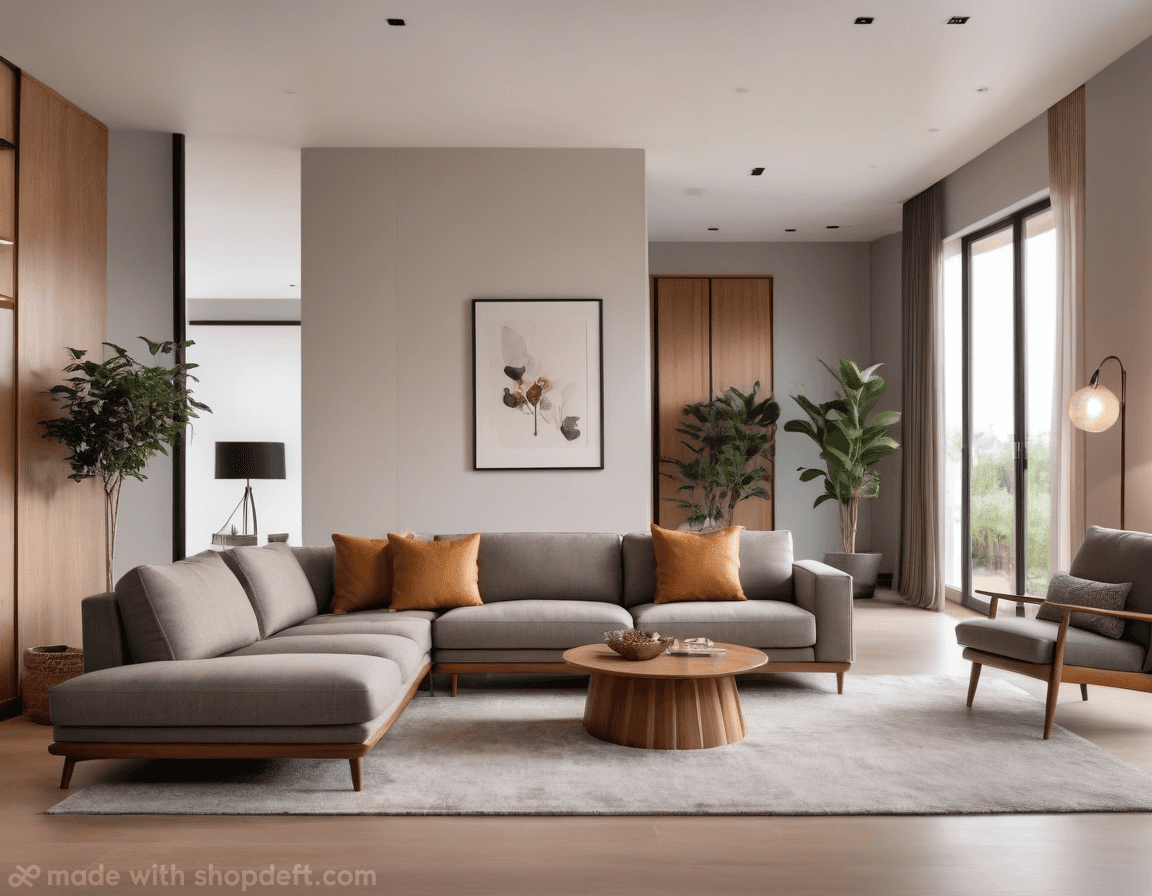Jun 19, 2024
•
Onton Team
In this post, we will dive into the core principles of Modern Design, introduce you to the visionary minds who shaped the movement, and provide tips for transforming your home into a Modern Design haven.
Have you ever craved a space that feels effortlessly stylish and transcends fleeting trends?
If so, you’re definitely into Modern Design. This design philosophy, born in the early 20th century, celebrates clean lines, functionality, and a connection to nature.
Understanding modern interior design
With roots planted firmly in the early 20th century, Modern design is a philosophy that extends far beyond aesthetics. The movement emphasizes calm, spacious interiors by rejecting ornament and embracing minimalism. Gone are the days of ornate decor. In Modern Design, clean lines and geometric forms take center stage.
Modern design champions the principle of form following function. Every element serves a purpose, leading to spaces that are both rational and simple.
This philosophy goes beyond four walls, blurring the lines between the interior and exterior. Integration with nature is key, using ample natural light and natural materials like wood, stone, and even indoor plants.
However, pioneering modern designers weren’t afraid to experiment with new materials like chrome and glass, creating sleek and functional pieces that hadn’t been seen before. This spirit of innovation and experimentation continues to be a hallmark of Modern Design.
Modern vs. Contemporary: How to spot the difference
The world of interior design is abuzz with terms like “modern” and “contemporary.” While modern and contemporary styles have their distinct characteristics, they also share a core principle: creating a functional and aesthetically pleasing space. Understanding the subtle differences can help you achieve your desired aesthetic more easily, especially when searching online or working with an interior designer.
Modern Design has a distinct historical origin. It pushes the boundaries of design while creating iconic pieces that remain relevant today.
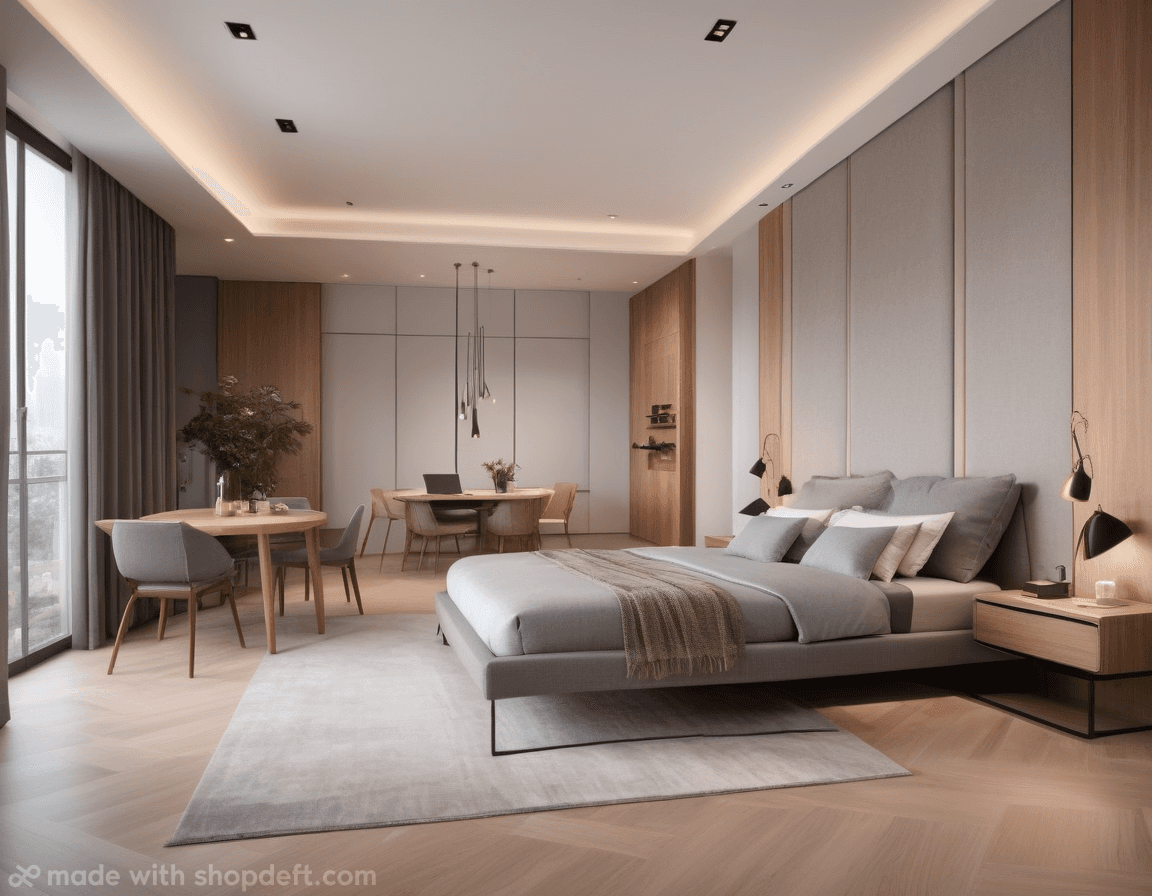
Unlike its historical counterpart, Contemporary Design is a more fluid concept. It’s not tied to a specific period but rather encompasses the current trends and styles that dominate the design world.
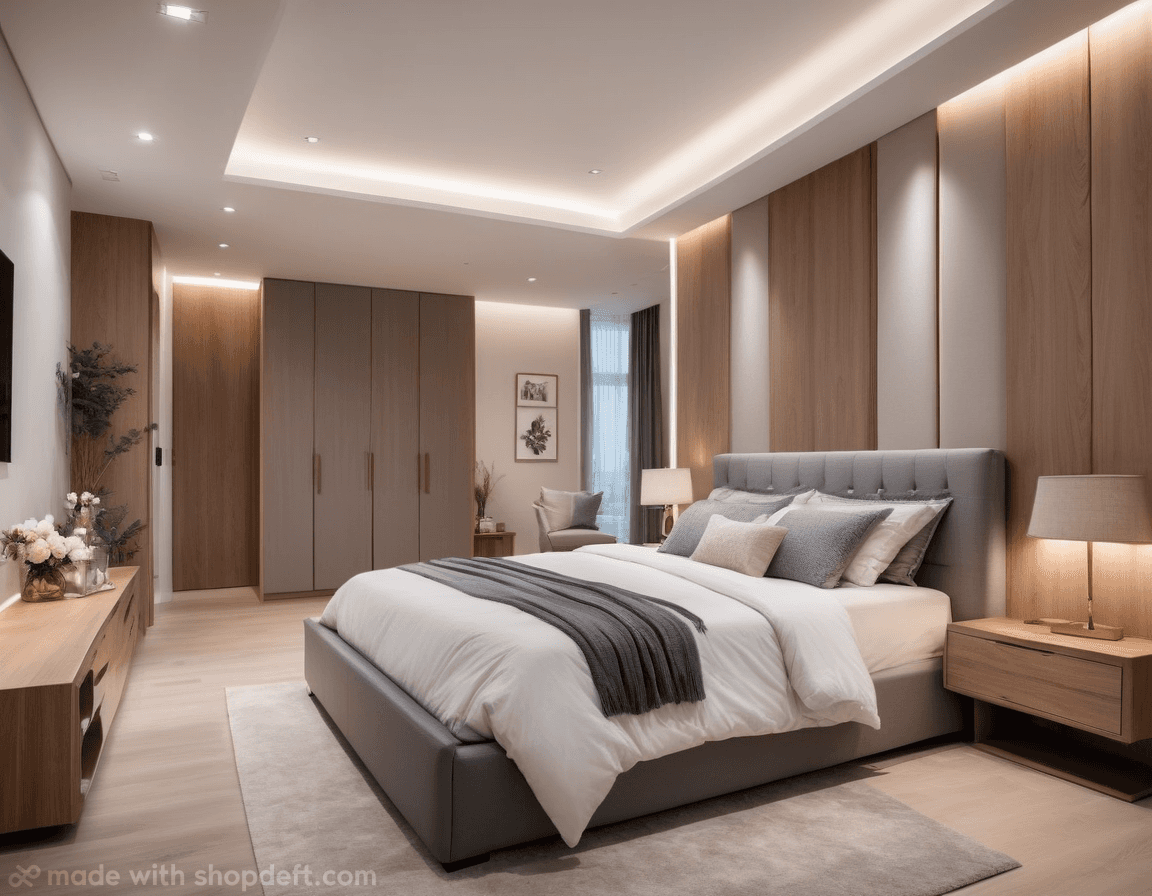
This means Contemporary Design can incorporate elements of modernism but is also open to borrowing from other styles like industrial, Scandinavian, or even mid-century modern. The key is to create a space that feels fresh, relevant, and reflects your own personal taste. Bold pops of color, statement pieces, and a mix of textures are all key elements of Contemporary Design.
The rise of modernism in art
While the roots of modernism can be traced back to the early 20th century, it wasn’t until the mid-20th century that it truly gained widespread traction. This period was characterized by a radical break from traditional styles, with artists embracing experimentation and innovation.
At the forefront of this artistic revolution stood a group of visionary designers who left an indelible mark on the world of interior design. Let’s meet some of these key figures:
George Nelson
A name synonymous with innovative furniture and lighting design, George Nelson was a champion of functionality and believed in creating beautiful objects for everyday use. His iconic Nelson Bubble Lamp, with its organic form and soft glow, is a testament to his forward-thinking approach.
Charles and Ray Eames
This dynamic husband-and-wife duo needs no introduction in the design world. Their creations, from the instantly recognizable Eames Lounge Chair to molded plywood furniture, revolutionized the concept of modern furniture. The Eameses were not just designers; they were also passionate educators who believed in the power of good design to enrich lives.
Florence Knoll
A pioneer in her own right, Florence Knoll championed clean lines and functionality in furniture design. She was instrumental in shaping the modern office aesthetic, creating sleek and efficient furniture that prioritized both form and function.
George Nakashima
As an American designer with a Japanese heritage, George Nakashima brought a unique perspective to modern furniture. He incorporated traditional Japanese woodworking techniques and a deep respect for natural materials into his creations. Nakashima’s furniture pieces are often characterized by their organic forms and beautiful integration of wood grains.
Hallmarks of modern style
Modern design is more than just aesthetic; it’s a philosophy that prioritizes clean lines, functionality, and a connection with nature. Here are the key elements that define the modern style:
Clean lines and geometric forms
Modern design embraces simplicity and clean lines. Think sleek sofas with sharp edges, geometric coffee tables, and uncluttered shelves. This focus on clean lines creates a sense of order and spaciousness, making even smaller rooms feel airy and inviting.
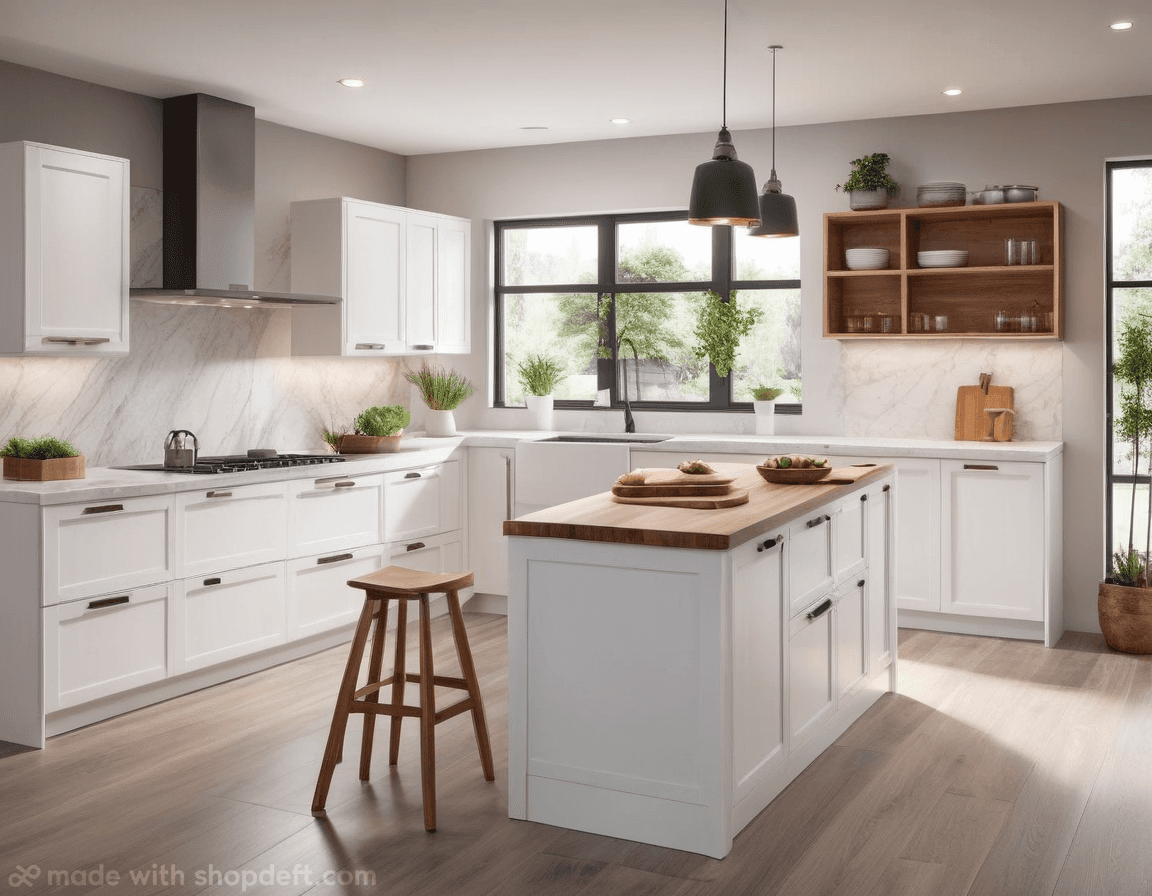
Neutral color palette
Modern interiors typically favor a neutral color palette. Whites, beiges, grays, and blacks form the foundation, often accented with pops of color from artwork, throw pillows, or accent furniture. This neutral palette creates a sense of calm and allows the clean lines and natural materials to take center stage.
Natural materials
Modern design celebrates the beauty of natural materials. Wood, stone, leather, and glass are all commonly used, bringing a sense of warmth and texture to the space.
A modern bedroom might boast a platform bed made of solid wood with clean lines. The natural wood grain adds warmth and visual interest, while the low profile of the platform bed creates a sense of spaciousness.
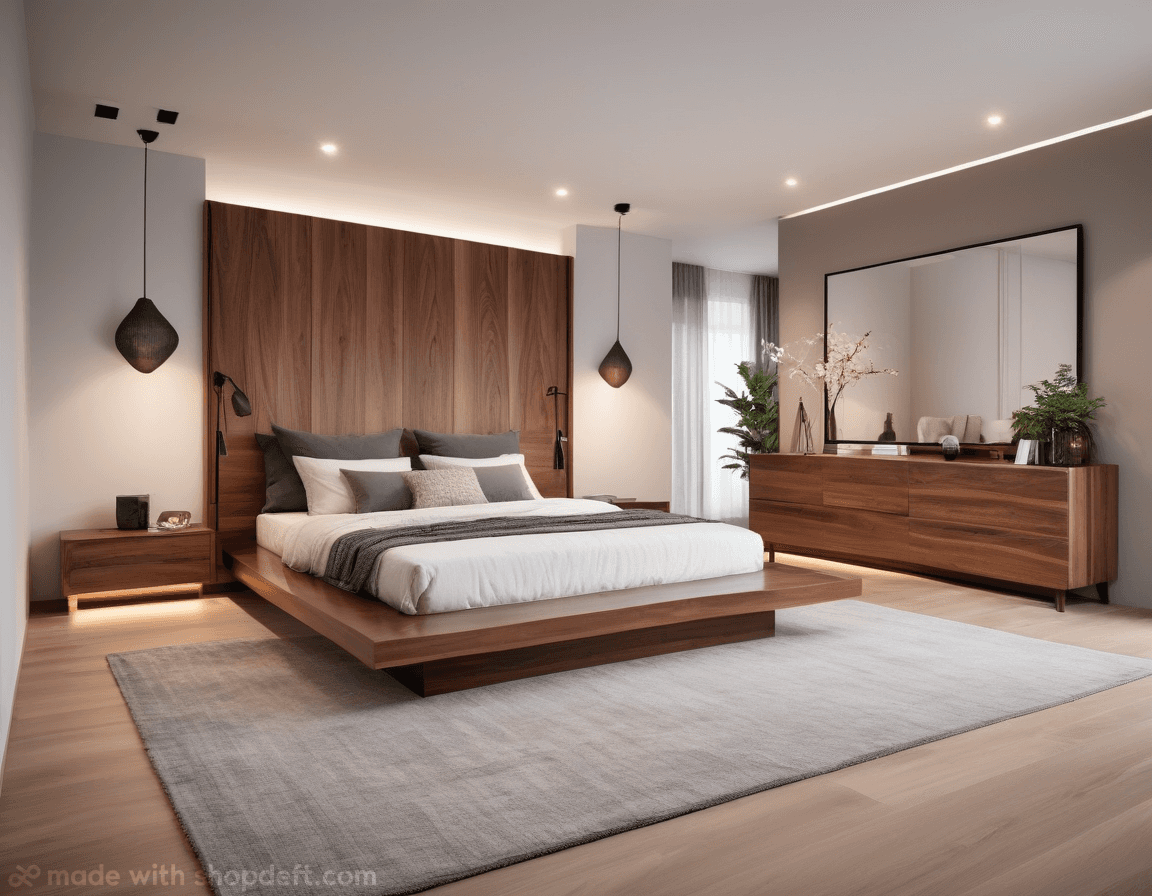
Low and long furniture
Modern furniture tends to be low-profile and long. This creates a sense of horizontal line and openness, making the space feel larger.
Imagine a spacious living room featuring a classic Mid-Century Modern (MCM) sofa with low legs and a long, sleek profile. This type of furniture doesn’t visually crowd the space and allows for a seamless flow of conversation and movement.
Open floor plans
A hallmark of Modern Design is the open floor plan. Walls are removed or minimized to create a sense of spaciousness and connection between different living areas. This allows for natural light to flow freely throughout the space and fosters a sense of togetherness.

How to create your Modern Design haven
Modern design is about creating a space that feels calming, functional, and reflects your love for simplicity. Here’s your guide to transforming your space into a modern haven:
1. Embrace the power of less: Simplicity reigns supreme
Modern design thrives on the principle of “less is more.” This means prioritizing clean lines and avoiding clutter. Think sleek furniture with sharp edges, uncluttered shelves, and open floor plans that allow the eye to travel freely. Declutter ruthlessly, letting go of anything that doesn’t spark joy or serve a purpose.
2. Choose functionality first: Every piece with a purpose
Modern design isn’t just about looks; it’s about creating a functional space that works for you. Every piece of furniture should serve a purpose. Invest in storage ottomans, nesting tables, and multi-functional furniture to maximize space and keep clutter at bay.
3. Incorporate nature’s touch: Warmth and character with natural materials
Incorporate the beauty of nature by bringing in natural materials like wood, stone, leather, and woven elements. A wood platform bed adds warmth to a bedroom, while a stone countertop in the kitchen brings a touch of sophistication. These materials not only create a sense of connection with the outdoors, but they also add visual interest and texture.
4. Let the sunshine in: Embrace the power of natural light
Natural light is a cornerstone of Modern Design. Maximize the use of windows and consider skylights to flood your space with natural light. This not only brightens the space but also creates a sense of openness and connection with the outdoors.
5. Open up and breathe: Move toward open floor plans
If your layout allows, consider creating an open floor plan. This involves removing or minimizing walls between different living areas, like the living room, dining area, and kitchen. Open floor plans promote a sense of spaciousness, allow for natural light to flow freely, and foster a more social atmosphere.
6. Consider industrial chic: A touch of edginess
For a unique twist on Modern Design, incorporate industrial chic. Think exposed brick walls, metal accents, or concrete floors. This adds a touch of edge and personality to your space, while still maintaining the core principles of clean lines and functionality.
7. Layer up for visual interest: The power of texture
Modern spaces can sometimes feel a bit sterile. Texture is your key to adding visual interest and warmth. Layer in rugs, throws, woven baskets, and artwork with varying textures to create a more inviting and visually stimulating space.
Embrace Modern Design in your home with Onton
Onton offers a suite of tools to empower you throughout your Modern Design journey:
Onton Discover
Spark your creativity and browse through a curated collection of inspiration for modern spaces with Onton Discover. Get a glimpse of the latest trends and discover how to incorporate Modern Design elements into your own home.
Onton Imagine
Onton Imagine allows you to play with design styles and see your dream space come to life. Upload a photo of your existing room or choose from a variety of pre-sets, and then use Onton Imagine to virtually redecorate in different modern styles. You can even specify the time period and mood you’re aiming for, allowing you to experiment and find the perfect look for your space.
Onton Search
Once you’ve honed in on your ideal Modern Design aesthetic, Onton Search is your one-stop shop to find the perfect furniture and décor to bring your vision to life. Search from a vast collection of modern pieces or use filters to narrow down your search by style, color, material, and more.
Onton Concierge
Need some expert advice? Onton Concierge is powered by AI and connects you with design professionals who can offer personalized recommendations and guidance. Their expert insight will help you navigate the world of Modern Design and create a space that reflects your unique style and needs.
Try Onton for free today and start modernizing your dream space in a snap.

